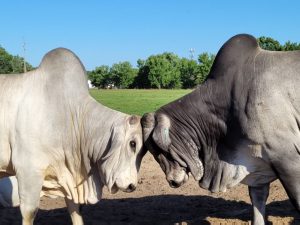Most of us are familiar with the long molecule that contains our genetic code, DNA. We are taught that our genetic code is made by combining our parent’s DNA, making something new and unique. But our parents are not the only factors influencing how the code is expressed. The environment around us, even before we are born, can also play a role in how our genetic code is interpreted and expressed. The observable expression of an organism’s genetic code is called its phenotype. Changes in the environment at significant points in development can result in phenotypic differences in people and other animals, like cows. The study of how the environment influences phenotype is called epigenetics. Epigenetic changes do not alter the original genetic code, but they do alter how the body “reads” the genetic code.
Epigenetics has been a growing topic in aminal science research. Scientists have been trying to understand how to epigenetics may be used to improve animal performance. Dr. Peter Hansen, a Distinguished Professor in the UF/IFAS Department of Animal Sciences, has been studying how the molecules added to a cow embryo’s early environment can impact how the adult cow grows and functions.
“We’re taught that an animal phenotype is a combination of genetics and its environment,” Hansen said. “So animal scientists have been trying to manipulate genetics to identify our best animals and propagate them. We’ve also been trying to give the animal the best environment possible. But we never really thought about the animal’s environment when it was a fetus or embryo. We used to only worry about it after it was born. So now we’re starting to worry about it when it’s even just a two-cell embryo.”
According to Hansen, this field of study dates back to the 1940s, and the studies on the Dutch hunger winter. Near the end of World War II, the German-occupied Netherlands suffered a severe famine in 1944. In the 1980s, epidemiologists looked at the men and women who were fetuses in 1944, Then they compared them to people who were fetuses in 1943 and 1945 when there was more plentiful food. They discovered a surprising phenomenon. The people who were fetuses when their mothers were hungry had different gene expressions than their same-sex siblings. This resulted in an increased incidence of heart disease and diabetes later in life.
“That discovery set off a whole field of research that says in fetal life you kind of get programmed for the environment you’re going to see as an adult,” Hansen said. “For example, if you’re living in a world without many nutrients, you kind of get programmed to live like that. But then if you find yourself in an environment with lots of nutrients, you know you have a higher rate of obesity because you’re not “programmed” right.”
In recent years, Hansen’s lab has been researching what molecules added to an embryo’s might have an impact on cows’ phenotypes. For embryos grown through in vitro fertilization (IFV), the first seven days of growth in the petri dish can influence the phenotype of the adult cow. Different molecules present in the petri dish can have different impacts.
One of the molecules the Hansen lab has investigated is colony-stimulating factor 2. This molecule was discovered in the immune system, but it’s also produced in the reproductive tract. Hansen treated embryos with colony-stimulating factor 2, hoping to increase the embryo’s ability to establish pregnancy. Unexpectedly, when the calves were measured after three months of age, they grew faster than the control calves. This study has only been completed once, so the Hansen lab plans on repeating it.

Choline is a micronutrient that you get from meat, and it provides methyl groups, or CH3’s. Those methyl groups cause DNA methylation, which can “turn off” certain genes. Some research has shown that feeding choline to dairy cows can influence milk production. Eliab Estrada, a doctoral student in Hansen’s lab, has been testing whether choline as an added molecule at the embryo stage would have any impact. It did not appear to have an impact on dairy cow milk production, but they kept testing choline in different scenarios and found something interesting.
“We transferred a bunch of Brahman embryos at the Beef Unit just to expand the herd, but then we treated half the embryos with choline and the other half without choline,” Hansen said. “The calves treated with choline were bigger at birth and even bigger at weaning. So while it didn’t seem to impact dairy cattle, it did appear to have an impact on the Brahman cattle’s growth. They were bigger at birth and bigger at weaning than the control calves.”
Now Estrada and Hansen are repeating their choline study to see if they can replicate the results.
 5
5
